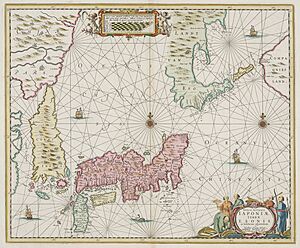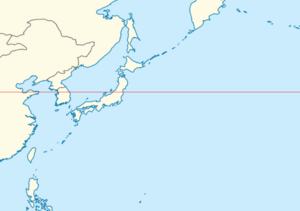Matthijs Quast facts for kids
Matthijs Hendrikszoon Quast (who died on October 6, 1641) was a Dutch merchant and explorer. He worked for the Dutch East India Company (VOC), a powerful trading company. Quast traveled to places like Tokugawa Japan, China, and Siam (now Thailand).
He is best known for his 1639 trip to find two mysterious islands called Rica de Oro (Rich in Gold) and Rica de Plata (Rich in Silver). Spanish sailors had reported seeing these islands before. Quast's trip didn't find the gold and silver islands, but he is sometimes given credit for being the first to officially discover the Bonin Islands. The VOC didn't do much with this information, and the islands stayed quiet until the 1800s.
Contents
The 1639 Expedition: Searching for Gold Islands

Stories about islands full of gold and silver in the southern or eastern seas are very old. Ancient Greeks called them Chryse and Argyre. For many years, Spanish sailors had placed their Isla Rica de Oro (Island Rich with Gold) and Rica de Plata (Rich with Silver) in different spots across the North Pacific.
Why the Expedition Started
Quast's journey began because of a report from December 7, 1635. Willem Verstegen, a VOC trader in Dejima (near Nagasaki, Japan), seemed to confirm the Spanish stories. He mentioned Kinshima (金島, "Island of Gold") and Ginshima (銀島, "Island of Silver"). These were supposedly somewhere east of Honshu, Japan. Verstegen specifically thought the islands were at 37° 30′ N. within 400 miles of Japan.
At first, VOC leaders in Batavia (now Jakarta, Indonesia) weren't interested. But the main bosses back in the Netherlands (called the Heeren XIX) ordered them to investigate.
Ships and Crew for the Journey
Quast was told to sail to the area where the Spanish and Japanese said the islands were. He was to go by way of the Philippines. After that, he was to continue northwest to explore Korea and look for a Northeast Passage around Mongolia, Manchuria, and Siberia.
The VOC usually saved its best ships for profitable trading trips. So, Quast's expedition was given two small, old ships: the Engel (Dutch for "Angel") and the Gracht ("Urban Canal"). Quast and his commander Lucas Albertsen used the Engel as their main ship. His lieutenant, Abel Tasman, was the captain of the Gracht. Tasman later became famous for his voyages to Australia.
The Search for the Islands
The expedition left Batavia on June 2, 1639. They sailed past Luzon and into the Pacific Ocean on July 10. Quast was very eager to find the two islands. He offered a bonus to the first person who spotted land. At the same time, he set very strict rules for anyone caught sleeping on watch. For the first time, they would get 50 lashes and lose a month's pay. The second time, it was twice as much. The third time, it was a very severe punishment, possibly death.
The two ships carefully searched the indicated areas. They went as far as 42° N. and 177° E.. They discovered or rediscovered the Bonin Islands, which were completely empty. However, they found nothing that looked like the gold and silver islands they were searching for.
End of the Expedition
The crew became very sick. This was made worse by poor food. The ships also started to break down. Quast finally gave up his search on October 25. Even though things were bad, he told his men to sail for Fort Zeelandia on Taiwan (now in Tainan). He decided not to try to continue northwest.
By the time his men reached Tayouan and its fort on November 24, 41 of the 90 men who had sailed with Quast had died.
Quast's Legacy

The Bonin Islands were empty, far away, and had no known resources or good harbors. Because of this, the Dutch East India Company completely ignored them. The Spanish had also ignored them before. This allowed the Japanese to rediscover and settle them later.
Quast's expedition added some details to Dutch maps of Japan's southern coast. But it didn't find anything vital or profitable. His journey was mostly forgotten until Philipp Franz von Siebold found its logs much later. He noticed maps of Dutch islands in the area where the Bonins were rediscovered.
The last part of Quast's mission, which he couldn't finish, was given to Martin de Vries. His expedition explored Hokkaido, Sakhalin, and the southern Kurils in 1643.


